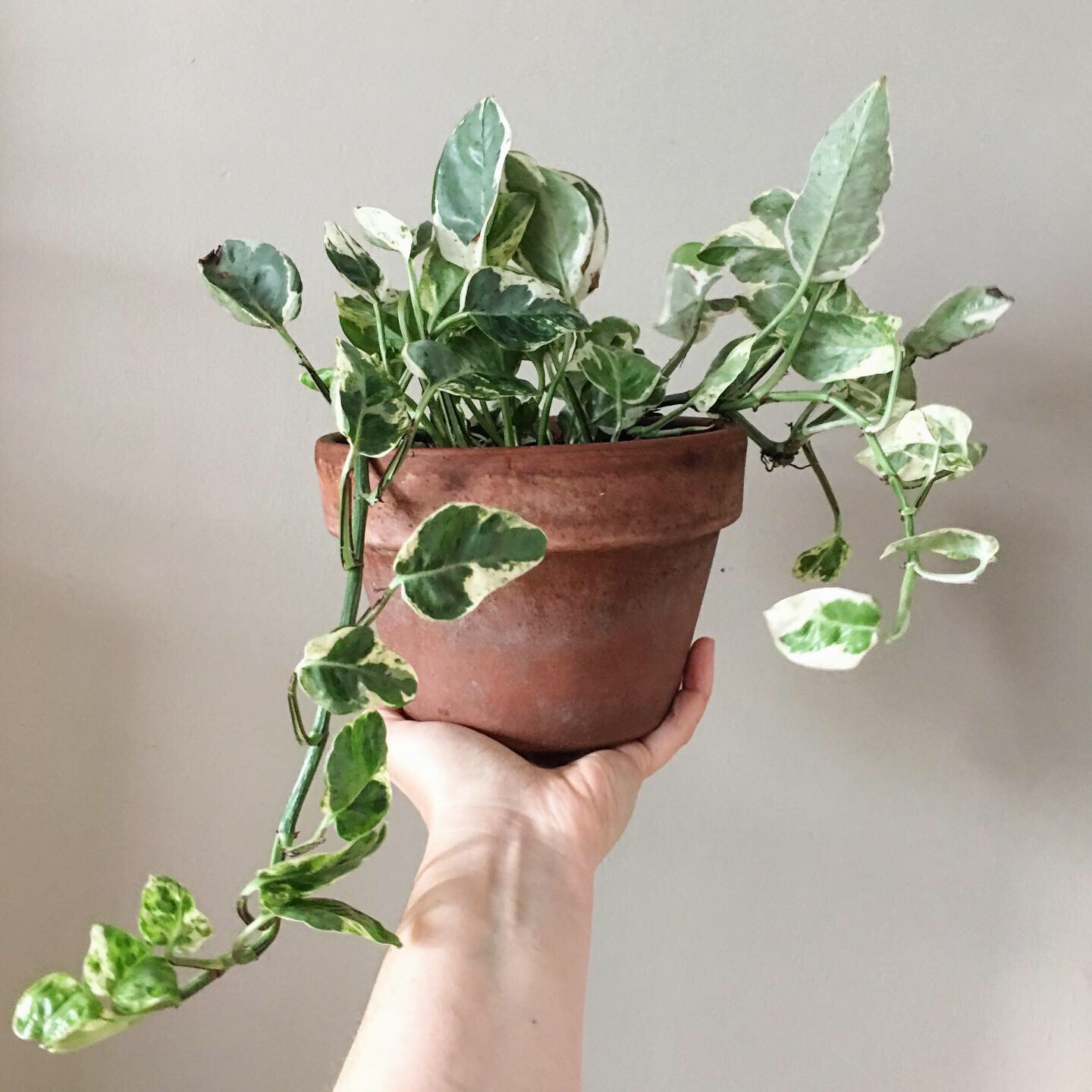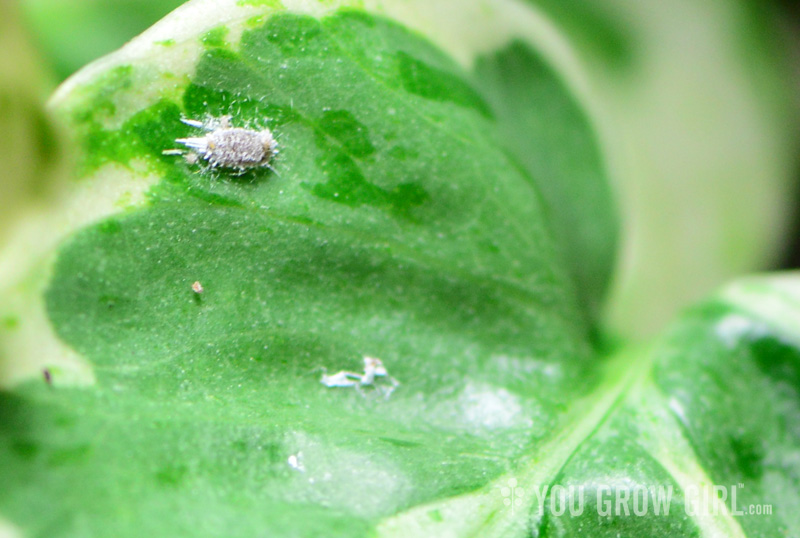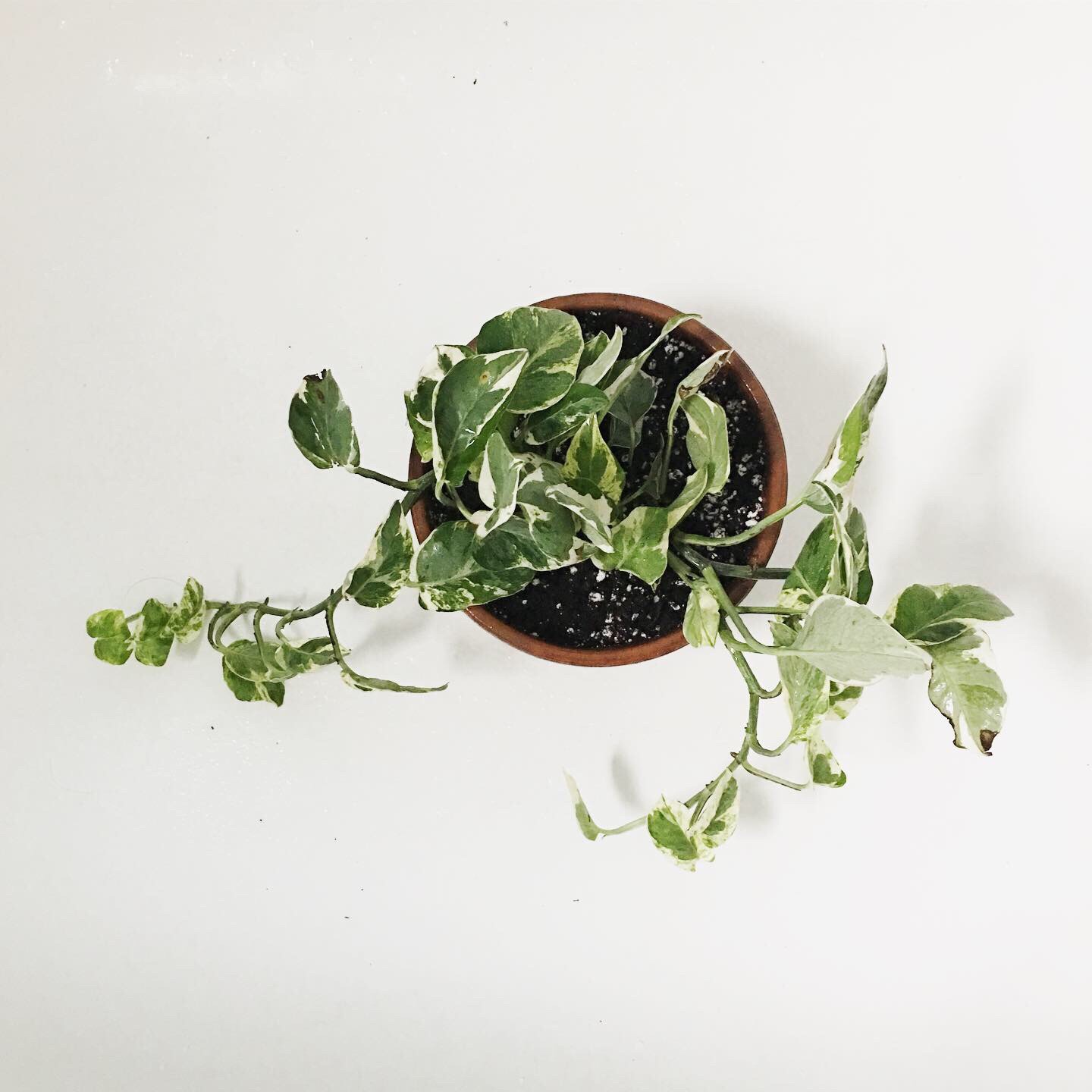
A small infestation of mealybug was recently found on this variegated pothos (Epipremnum). I check my houseplants regularly, but they were camouflaged well against the white variegation. Of the many pests that can plague houseplants, mealybug are the one I’ve come up against most. This may be because I keep a lot of succulent plants, and while they are an equal opportunity pest, they seem to favour some succulents particularly. I love the variegation and beautiful elongated shape of these leaves and did not want to lose this plant, so I left into action, knowing from experience that the best shot in dealing with them is in acting quickly.

Mealy bugs are a soft-bodied invertebrate that suck sap from the tender growth of a wide range of plants.
Here’s my go-to method for dealing with mealybug:
1. The colony was not insurmountable to tackle, but was fairly well established and I suspected that adults, nymphs, and eggs (the complete lifecycle) would need to be addressed. The first thing I did was hose the plant down in the shower, running my fingers over every leaf surface and using a wet Q-tip to get into the nooks and crannies where the leaves meet the stems. This is where they are most likely to hang out, especially once you start working to combat them. The other place to look frequently is around new growth — all pest insects prefer the most tender parts of a plant. This initial shower is just a cursory bath to remove as many of the adult insects as possible.

2. Next, I sprayed the entire plant down (underneath leaves and the soil) with a neem spray that I make using concentrated neem oil diluted to 1/2 tsp oil to 1 litre of water. You can also add the same amount of insecticidal soap or a common liquid soap such as Dr. Bronners unscented. I personally prefer neem concentrate over a pre-mixed spray product because it is better value for the dollar, I like that I can control the dilution (using a more diluted spray for more tender plants), and find that even a small bottle of concentrate will last years. Mine was purchased from Urban Harvest here in Toronto, but they don’t have it available online, so I’d recommend a product such as this instead. Neem is a systemic that works when the plant takes it into its tissues, making the leaves unpalatable/repellant and sometimes even deadly to some insects. While applying the spray repeatedly doesn’t always kill insects directly, it ensures that any lingering adults or newly hatched babies no longer have an edible food source further down the road. Please note that neem has a smell, sort of garlicky/spicy. I am sensitive to the smell so always spray in the bathtub since I can clean it afterward and the spray isn’t in the air.
In lieu of neem oil spray you can also try using a garlic or garlic and pepper spray (or this one that uses up the tough stems from garlic scapes).
3. Once sprayed, I quarantined the plant away from any others. This can be difficult to do, but the good news is that mealybug do not fly, so a quarantine doesn’t have to be far.
3. The next day, I went over the whole plant with a cotton swab dipped in diluted isopropyl alcohol, dabbing at each mealybug I saw and digging deep into those nooks and crannies again. I find that on the second day this is often where they retreat to. Some people spray the entire plant, but I’ve never used isopropyl alcohol on pathos leaves so I wanted to play it safe to begin. I repeated this action every day for a week and found that there was no leaf burning with the diluted alcohol and have since bumped up to using it full strength directly from the bottle.
4. I followed up the initial application of with another application of neem spray and have since cut back applications to weekly. This is not an easy pest to get rid of, but it is possible. After a few weeks I find that their appearance lessens and I can reduce to checking bi-weekly and eventually just weekly.
Further Tips: The key to making sure you get them all is in checking diligently and repeating the above processes, especially in the first weeks. In some instances, I remove the plant from the soil and wash all the way down to the roots. This is needed most when the infestation is more intense and with succulents such as agave or sansevieria. I’ve had infestations that get way down into the centre of the rosette and become impossible to remove without going to this length.
The other important key here is to check neighbouring plants. I have a beautiful Monstera adonsonii hanging next to this plants, with some leaves touching. On first glance the M. adonsonii looked untouched, but I found some when I looked more closely underneath a light, especially way up in those grooves where the new leaves emerge from the stem. So as of now I am following this process for both plants, with small mealybugs still appearing now and again on the pothos where the infestation started.
Last Thoughts: Some version of this treatment is how I approach most pest infestations indoors. The other key factor is in keeping your plants as healthy as you can since healthier plants are more resilient to pests and poor growing conditions can play a big role in whether or not a pest can thrive in the first place. While this is how I treat indoor, houseplants, it is not how I approach pest control in my outdoor garden. While I did use organic, “safer” sprays such as neem years ago, I no longer use sprays of any kind. Outdoors my growing strategy is to create a balanced ecosystem in which predatory insects are on hand to keep pest populations in check. I have other little tricks that I employ as well that I won’t get into in this post. However, indoors we are working with a less-than-ideal, artificial environment. Pest pressures are more intense as a result, so I don’t mind using a spray such as neem now and again to help eradicate hard-to-manage pests.
For years, when one of my houseplants got buggy, I would throw it out and replace it with another or something completely different. But, as I have gotten older, many of my plants have fond memories associated with them and/or were a gift from a friend that I want to keep. Thanks for the article and all the tips. I don’t have mealy bugs as of yet, but I do have spider mites and can use some of the same remedies of them.
Yes, I do pretty much the same thing for spider mites. Only difference is a focus on humidity because they thrive in drier conditions. I have a Ficus religiosa that gets spider mites every winter. I do the best I can, but the only place for it with the right light, doesn’t have high enough humidity as the space is shared with desert succulents. Such a pain, but I can’t quit it because the leaves are so beautiful
You’re so diligent! I had an infestation last year on one of my plants too! What a mess! I tried to save it but failed! So thank you for taking the time to write out what worked for you, as I’ll now have this in my arsenal given I ever need to ward off those pesky pests again!
I have lost plants to mealy bug too, especially agave since it can be near impossible to get them in the cracks and crevices without uprooting the plant and washing everything off multiple times. But I don’t want to lose this pothos and it’s a bit easier to work at so I keep at it.
Glad you were able to take care of the mealybug!
I believe I heard ladybugs are also effective at preventing mealybug. Is that true or am I just remembering incorrectly?
Yes, there are certainly predator insects that you can purchase to help deal with them, but in this case it’s just two plants and not a big enough outbreak to warrant going that route.
I had literally *nothing* available and didn’t want to wait on Amazon years ago with a small succulent… I used flipping Febreeze. IT WORKED! I felt awful and my plant stank until next summer when I could put it on the patio table but IT WORKED. :(
I’m not surprised. Febreeze is a pretty noxious chemical… that could certainly kill a soft-bodied insect. Next time try some dish soap. Less harmful to the plant and beneficial soil organisms.